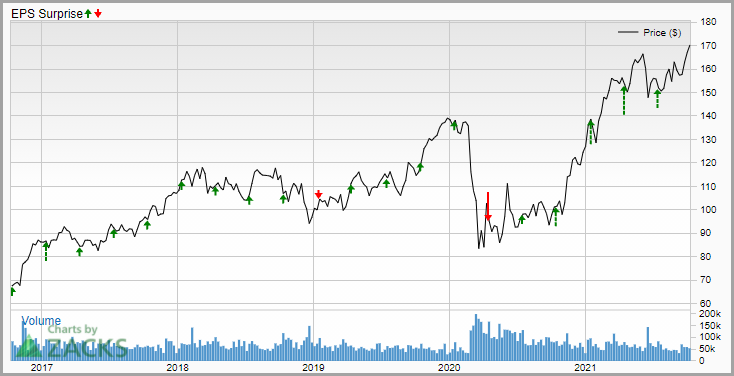JPMorgan, Daily
The trading activity and the decline in market volatility during the 3rd quarter ending in September is expected to have dampened most of the trading business, not to mention members of the banking sector such as JPMorgan. Concerns over the financial impact of the potential failure of the Evergrande property group and the debate over the debt ceiling are making most investors nervous. It is these factors that led to high levels of equity market volatility during the last few weeks of September. On the other hand, bond trading remained weak in the third quarter, and concerns over the accelerated rate of Delta variant infections, warming inflation, slowing Chinese growth, fading fiscal stimulus and easing of bond purchases by the Federal Reserve added to the sentiment.
JPMorgan reported net income of $11.9 billion, or $3.78 per share, in its second quarter release on July 13 kuartal kedua . Record earnings over the past year have resulted from booming stock and bond trading, a surge in advice fees amid a flood of IPO and M&A activity, and the release of billions of dollars in reserves to offset falling demand for loans and the impact of record low interest rates on net interest income. Q3 has now ended and JP Morgan is expected to report earnings for the fiscal quarter ending in September 2021 on Wednesday, October 13 before the market opens. According to Zacks Investment Research, based on 7 analyst estimates, the consensus EPS forecast for the quarter is $2.99. Reported EPS for the same quarter last year was $2.92 with equity rating at #3 (Hold).

Sluggish loan demand is showing signs of a bottom-out and has started to bounce back. The hope is that the economic recovery will get enough pace at this time to spur an increase in lending for JPMorgan, as the company looks to take advantage of new opportunities. However, the biggest concern is that the rate hike anticipated next year will dampen the appetite for new loans, although this will clearly benefit net interest income as the main revenue driver for JPMorgan.
The uncertain outlook still pervades the banking sector, distracted by the anticipated rate hikes, coming at a time when they face rising costs. JPMorgan has raised its spending expectations for 2021 several times as it has had to pay more to attract staff and invest large amounts of technology to prevent competition from more digitally savvy fintech competitors looking to seize their business.
Overall, the factors that will affect the results of hasil Q3 include:
Investment Banking Fees: Both deal volume and total value witnessed a drastic increase. Thus, it has most likely resulted in an increase in consulting fees.
Mortgage Banking Fees: Low mortgage interest rates continued to drive mortgage demand during the third quarter of 2021 leading to an increase in new originations. A gradual slowdown in refinancing activity and faster prepayments weighed on the mortgage banking business.
Net Interest Income (NII): Demand for loans (except for commercial and industrial per Fed data) saw a marginal increase during the third quarter of 2021. Demand for real estate and consumer loans also increased during the quarter. This, together with the improvement in the yield curve (difference between short-term and long-term interest rates) during the quarter, is expected to have supported some of JPMorgan’s net interest results and NII. However, the persistently low interest rate environment remains a drag.
Operating Expenses: JPMorgan’s plan to enter new markets by opening more branches, which is on track, together with inorganic expansion efforts, is likely to result in an increase in operating expenses during the third quarter. Investments in technology to strengthen digital offerings may also lead to cost increases in the quarter to be reported.
Asset Quality: Continuing the trend of the last four quarters and driven by an improving macroeconomic backdrop and stable credit market conditions, JPMorgan is likely to release reserves that were taken up to cover losses from the impact of the coronavirus pandemic. This is expected to support the company’s earnings in the quarter to be reported.

(#JPMorgan) recorded +4.9% growth throughout July to September. And at the beginning of October it again recorded a record peak price at 171.48. However earlier this week, ahead of Wednesday’s Q3 2021 earnings report, the asset price has corrected by -2.8% and is trading at a price of around 166.51, below the September peak of 169.29. The price structure still tends to show a bullish bias, after breaking through two highs of 163.82 and 167.24. As long as the support at 150.48, which is above the 200-day EMA, holds, the bullish prospect will still dominate. The current price position is still above the 20-day (blue line) and 50-day (yellow line) exponential moving averages with the closest support at 162.74. If there is a break of this price level, the asset may be stuck at the 61.8% retracement level (158.47) as part of the correction from the 150.48 advance. On the upside, a move above the 171.48 peak would extend September’s gains targeting 177.25. The RSI shows a declining momentum after touching the 68 level and the MACD also shows a slowdown in the rally momentum with the signal line almost crossing the histogram, but overall the outlook is still bullish.
Click here to access our Economic Calendar
Ady Phangestu
Market Analyst
Disclaimer: This material is provided as a general marketing communication for information purposes only and does not constitute an independent investment research. Nothing in this communication contains, or should be considered as containing, an investment advice or an investment recommendation or a solicitation for the purpose of buying or selling of any financial instrument. All information provided is gathered from reputable sources and any information containing an indication of past performance is not a guarantee or reliable indicator of future performance. Users acknowledge that any investment in Leveraged Products is characterized by a certain degree of uncertainty and that any investment of this nature involves a high level of risk for which the users are solely responsible and liable. We assume no liability for any loss arising from any investment made based on the information provided in this communication. This communication must not be reproduced or further distributed without our prior written permission.



















